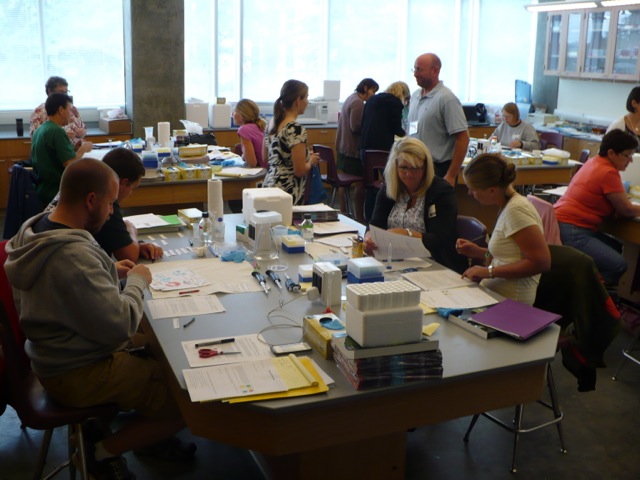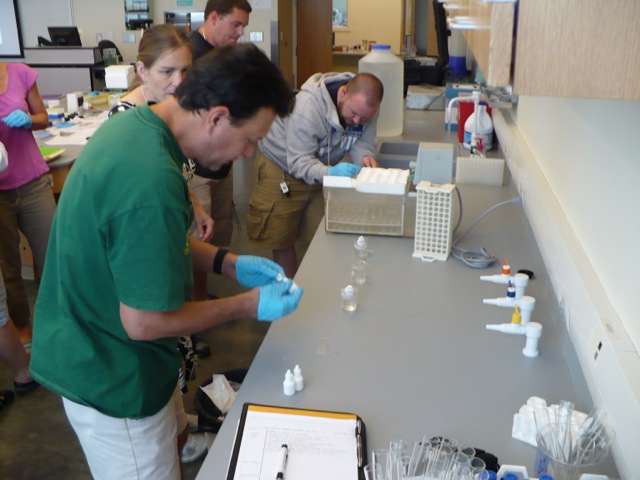
Teachers Study Stem Cells in Asheville Workshop
 |
By Jeremy Summers, NCBiotech Writer
Stem cells have the potential to unlock solutions to a wide array of medical problems. In recent years, stem cells have been incorporated into innovative and successful therapies for cancer and HIV.
But the ethical questions inherent to stem cells make this one of the most hotly-debated topics in science today, which is why instructors chose to make stem cells the focus of a teacher workshop in Asheville last week.
The workshop, titled “Stem Cells: Their Sources, Therapeutic Uses, and Fates,” was part of the North Carolina Biotechnology Center’s 2012 Summer Biotechnology Workshops for Educators.
These workshops introduce teachers at any grade level to new and exciting methods for teaching biotechnology in their classrooms. Held in the biology labs at the University of North Carolina at Asheville, last week’s workshop prepared high school and community college teachers to discuss stem and cell therapies with their students. The workshop also prepared these educators to teach their students about the potential applications of stem cells, as well as how they relate to biotechnology laboratory techniques. Teachers will be able to take these lessons back to their classrooms to engage their students and get them interested in science.
Staying up to date
Stem cells, which are found in all multicellular organisms, have the ability to divide and self-renew. They also have the ability to adapt to a specialized purpose, such as regenerating tissue. This makes them particularly useful in treating disease but also very controversial.
Last year, the North Carolina Department of Public Instruction, which regulates the standard course of study for grades K-12 in the state’s public schools, began including stem cells as an area of focus within the mandated curriculum.
This change prompted Jennifer Rhode Ward, Ph.D., the workshop’s lead instructor, to center the teacher workshop around stem cells. Ward said she wanted teachers to learn about what exactly stem cells are, how the different types differentiate from one another and how to detect different modes of differentiation.
Ward said the teachers, many of whom had no experience with stem cells, were good about asking questions when they needed clarification on something. “We are very pleased about how the teachers are communicating their needs,” said Ward.
One of the teachers who attended the workshop was Laura Roberts, a biology teacher at Enka High School in Candler, just outside of Asheville.
When she heard that stem cells would be the focus of the workshop, Roberts was eager to sign up and learn more about them so that she would be better-equipped to teach her students starting in the fall.
“It’s been a long time since I’ve had cutting-edge instruction,” said Roberts.
Roberts said she was very pleased that teachers in the workshop received “college level instruction to enhance our knowledge.” Roberts added that her primary takeaway from the workshop will be the wealth of “latest information on stem cell research” she accumulated in just a few days.
Hands-on learning
Ward said the workshop was made up of “really enthusiastic” teachers eager to sink their teeth into the wide range of activities prepared for them. The instructors emphasized “trying to meet their expectations by giving them a range of exercises,” said Ward.
The instructors accomplished this by incorporating wet and dry lab exercises into the workshop’s labs, giving the teachers the opportunity to familiarize themselves with both the basic biological concepts and the practical human health applications of stem cells.
Among the topics the instructors focused on was gene expression, which allows scientists to see which genes the body has decided to “turn on” and which ones it has decided to “turn off.” The expression of genes is what gives a person certain characteristics, such as having brown hair, and also what makes them predisposed to certain types of disease.
 |
| Teachers perform a paper simulation of a microarray. |
Teachers had the opportunity to go beyond the theories of these concepts and participate in the type of hands-on learning that is often very effective in their own classrooms. The intensive labs included a paper simulation of a microarray. Microarrays, or collections of microscopic DNA particles attached to a solid surface, allow a huge amount of DNA information to be contained in a very small area. For this reason, they are especially useful in analyzing genes.
However, the cost of microarray testing is also very expensive, so the teachers were able to simulate this test on paper. While less sophisticated than performing the test using expensive equipment, the basic concept in the paper simulations remains the same. These simulations allowed the teachers to discover how parts of a genome that may contain cancerous cells are first detected. The teachers can take back this simulation to their own classrooms and set it up for their students to perform, using the lessons and materials they received in the workshop.
While the inclusion of stem cells in the state’s new standards will hopefully get more students interested in science, it also reflects the importance of biotechnology in the state. Ward said she is pleased that the state’s curriculum is evolving to become more “biotech-oriented,” and wanted the workshop to give teachers the “tools to meet the standards.”
